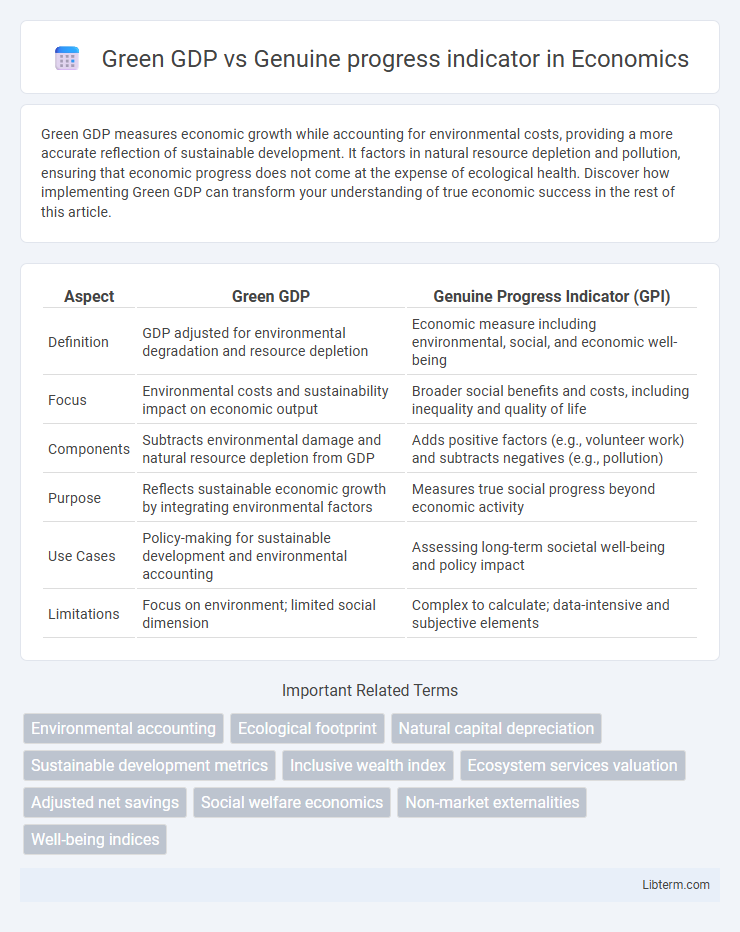Green GDP measures economic growth while accounting for environmental costs, providing a more accurate reflection of sustainable development. It factors in natural resource depletion and pollution, ensuring that economic progress does not come at the expense of ecological health. Discover how implementing Green GDP can transform your understanding of true economic success in the rest of this article.
Table of Comparison
| Aspect | Green GDP | Genuine Progress Indicator (GPI) |
|---|---|---|
| Definition | GDP adjusted for environmental degradation and resource depletion | Economic measure including environmental, social, and economic well-being |
| Focus | Environmental costs and sustainability impact on economic output | Broader social benefits and costs, including inequality and quality of life |
| Components | Subtracts environmental damage and natural resource depletion from GDP | Adds positive factors (e.g., volunteer work) and subtracts negatives (e.g., pollution) |
| Purpose | Reflects sustainable economic growth by integrating environmental factors | Measures true social progress beyond economic activity |
| Use Cases | Policy-making for sustainable development and environmental accounting | Assessing long-term societal well-being and policy impact |
| Limitations | Focus on environment; limited social dimension | Complex to calculate; data-intensive and subjective elements |
Introduction to Green GDP and Genuine Progress Indicator
Green GDP measures economic growth adjusted for environmental degradation and resource depletion, providing a more sustainable assessment than traditional GDP. The Genuine Progress Indicator (GPI) incorporates economic, social, and environmental factors, including income distribution, volunteer work, and pollution costs, to reflect overall well-being. Both metrics aim to offer a comprehensive understanding of progress beyond mere economic output.
Defining Green GDP: Concepts and Components
Green GDP measures economic growth by adjusting traditional GDP for environmental costs such as pollution and resource depletion, incorporating factors like carbon emissions, deforestation, and water usage. It emphasizes sustainable development by quantifying the ecological impact of economic activities, providing a more accurate representation of long-term economic health. Key components include natural resource valuation, environmental degradation costs, and ecosystem service losses, reflecting the balance between economic output and environmental sustainability.
Understanding the Genuine Progress Indicator (GPI)
The Genuine Progress Indicator (GPI) measures economic progress by incorporating environmental health, social well-being, and income distribution, unlike Green GDP which adjusts traditional GDP solely for environmental costs. GPI accounts for factors such as natural resource depletion, pollution, and social inequities, providing a more comprehensive assessment of sustainable development and quality of life. This holistic approach supports policymakers in making decisions that foster long-term economic stability and environmental stewardship.
Key Differences Between Green GDP and GPI
Green GDP measures economic growth by adjusting traditional GDP to account for environmental degradation and resource depletion, emphasizing the monetary valuation of natural capital losses. Genuine Progress Indicator (GPI) expands beyond economic output to include social and environmental factors such as income distribution, health, and ecological well-being, providing a broader assessment of sustainable development. Key differences lie in Green GDP's focus on environmental costs related to economic activity, while GPI integrates economic, social, and environmental dimensions to evaluate overall societal progress.
Environmental Accounting in Green GDP
Green GDP incorporates environmental accounting by adjusting traditional GDP to reflect the depletion of natural resources and environmental degradation, offering a more accurate measure of sustainable economic growth. It quantifies costs related to pollution, deforestation, and carbon emissions, converting these environmental losses into economic terms. Unlike the Genuine Progress Indicator, which also factors social and economic well-being, Green GDP specifically emphasizes the ecological impacts within national accounting frameworks.
Social and Economic Factors in GPI
Green GDP adjusts traditional GDP by accounting for environmental degradation and resource depletion, providing a greener economic measure. Genuine Progress Indicator (GPI) incorporates social and economic factors such as income distribution, non-market labor, and crime rates, offering a broader assessment of societal well-being. GPI's inclusion of factors like education quality, healthcare access, and environmental costs enables a comprehensive evaluation of sustainable economic progress.
Strengths and Limitations of Green GDP
Green GDP measures economic growth by adjusting traditional GDP for environmental degradation and resource depletion, providing a more accurate reflection of sustainable development. Its strengths include highlighting the economic costs of environmental harm and promoting policies for sustainable resource management. However, limitations arise from difficulties in accurately quantifying environmental damage, data inconsistency, and potential undervaluation of ecosystem services.
Advantages and Criticisms of GPI
The Genuine Progress Indicator (GPI) offers a comprehensive measure of economic well-being by incorporating environmental, social, and economic factors, unlike Green GDP, which adjusts traditional GDP solely for environmental costs. GPI advantages include accounting for income distribution, environmental degradation, and social costs, providing a more holistic view of sustainable development. Criticisms of GPI focus on the complexity of data collection, subjective valuation of non-market factors, and difficulties in standardizing the indicator across regions.
Policy Implications: Green GDP vs GPI
Green GDP offers policymakers a refined economic growth metric by adjusting for environmental degradation, guiding regulations that prioritize sustainable resource use and pollution control. Genuine Progress Indicator (GPI) extends beyond economic output to incorporate social welfare and environmental health, influencing policies that address income distribution, social equity, and ecosystem preservation. Comparing these approaches, Green GDP primarily shapes environmental economic adjustments, whereas GPI drives comprehensive policy frameworks that balance economic, social, and environmental objectives.
Future Prospects for Sustainable Development Metrics
Green GDP and Genuine Progress Indicator (GPI) offer promising frameworks for integrating environmental and social factors into economic assessments, addressing shortcomings of traditional GDP. Future prospects for sustainable development metrics involve enhancing data precision through satellite monitoring and big data analytics to better capture ecological degradation and social welfare impacts. Emphasizing these refined indicators supports policymakers in crafting more balanced strategies for long-term sustainability and equitable growth.
Green GDP Infographic

 libterm.com
libterm.com